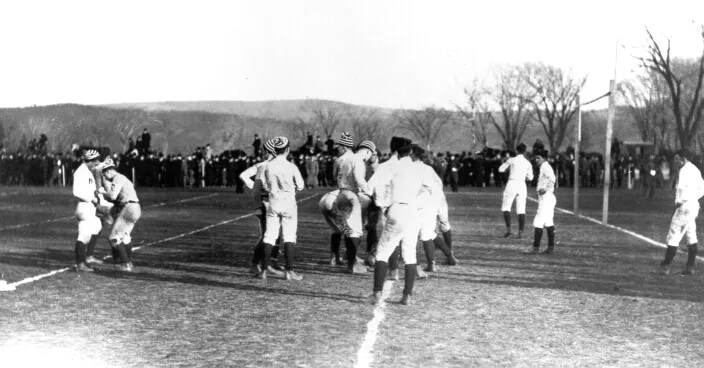There is perhaps no college football rivalry more intense, more enduring than that between the Army Black Knights out of West Point and the Navy Midshipmen out of Annapolis. The Army-Navy game, presented by USAA, is truly iconic. It is the embodiment of the brotherly rivalry between soldiers and their sailor and Marine counterparts.
Over the years, these two teams have clashed 121 times, making for some outstanding games. The following five games are rated without personal branch preference, focusing on both the quality of the game and the impact each had on military history. So, for example, the 1893 Navy victory that almost lead to a duel between a General and an Admiral has been glossed over because, frankly, the game itself wasn’t too spectacular.
Here are the top 5 Army-Navy games in the rivalry’s history
*Honorable Mention* 1890: Army 0 — Navy 24
You can’t talk about this rivalry without first bringing up the game that started it all. The Naval Academy had been around for 11 years at this point and they wanted to put on a friendly game against the newly established Military Academy (Army) team. Despite not having a coach, the Midshipmen each chipped in 52 cents to pay for half of the traveling costs to get to West Point to play on “The Plain.” A tradition was born.

1. 1973: Army 0 — Navy 51
In 1973, the Navy team had been decent enough. But something special was in the air that year at John F. Kennedy Stadium, and the Navy team caught fire for one game, wracking up 460 total yards and five recovered turnovers. In fact, two Navy players had over 100 rushing yards: Ed Gilmore with 123 and Cleveland Cooper with 102.
It’s a damn shame that they won this “astounding victory” against a team that was just plain bad. That year, the Army lost every game — all but three of which were by 29 points or more. In fact, when the rivals faced off, Army lost by more points than the entire team had scored that season, which was only 42. If you want to joke about the Army’s football history, point to this year …or 2003’s 0 and 13 season …or the 14-year losing streak.
2. 2016: Army 21 — Navy 17
The best game in recent history happens to share the distinction of being the game where the 14-year Navy win steak was finally snapped. Army intercepted two of Navy QB Zach Abey’s passes and went into halftime with a 14-0 lead; it was the middle finger the Army needed to prove they weren’t showing up for a 15th consecutive defeat.
The Midshipmen came back from the locker room ready for a new game. They straightened up with two touchdowns on 19 carries and a field goal. Even though they tried to shake things up with a few read options, the underdog Army was too damn relentless and snagged a well-earned and much needed victory.

3. 1926: Army 21 — Navy 21
In front of 110,000 spectators, Soldier Field in Chicago was dedicated to all of those lost fighting for America with that year’s Army-Navy game. Both teams were dominant: The Army had only lost once (to Notre Dame) and had shutout five teams. The Navy was undefeated.
The game was a complete stalemate. Both teams threw everything they had at each other, but they were too evenly matched. They played to the point of near darkness when the game was finally called and deemed a tie at 21 to 21.

4. 1944: Army 23 — Navy 7
The Army-Navy game of 1944 is often called, “The (original) Game of the Century” and was set to the backdrop of America’s entrance into WWII. Shortly after Metz, France was liberated and just before the Battle of the Bulge, on December 2, 1944, the #1 ranked Army played the #2 ranked Navy in what many considered the de facto national championship.
All eyes were on the game and it did not disappoint. Just a few years prior, the abysmal 1-7-1 Army team of 1940 almost caused military leaders to can the entire program. A short four years later, the team was unstoppable. On the season, the offense took 504 points and the defense only allowed 35. Glenn Davis, Army RB, was honored with the Maxwell Award that year and, eventually, the Heisman in ’46. Army was looking to snap a 5-year losing streak to the Navy, who were also dominant in ’44.
With WWII on the everyone’s mind, the country’s eyes were glued to the game. Despite stiff competition, Army claimed victory and the first of three consecutive National Championships.

5. 1963: Army 15 — Navy 21
Not only was the game itself amazing, but the circumstances surrounding the 1963 showdown makes it the “Greatest Army-Navy Game,” according to various sources.
The Army-Navy game took place just two weeks after President John F. Kennedy was assassinated. Military tradition dictates a 30-day national period of mourning, but just four days after the tragedy, it was announced the game was on. Sources say that it was Jacqueline Kennedy who wanted the game her husband loved to continue. It was also the same day star Navy quarterback, Roger Staubach, was awarded the Heisman.
America needed this game and Staubach found his match in his ultimate rival, Army QB Rollie Stichweh. Army took an early lead and stopped Navy with a goal-line stand, but Navy FB Pat Donnelly responded with three touchdowns, putting the Midshipmen up 21-7 with ten minutes left. Then, the Army mounted a surprising comeback, refusing to give up the ball. A touchdown and a 2-point conversion later, Army was just a possession away from victory, but the clock was ticking. The entire country watched, out of their seats. Despite an amazing effort, the Navy was saved by the buzzer, which stopped Army at the 2-yard line.


